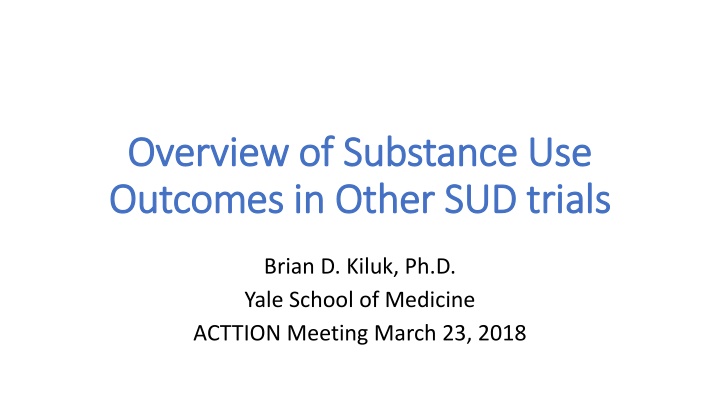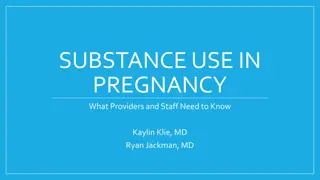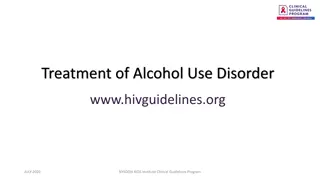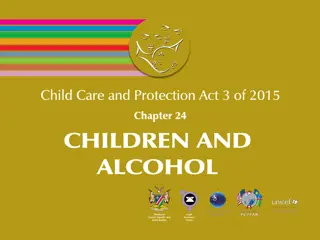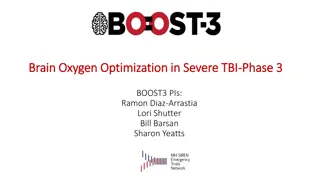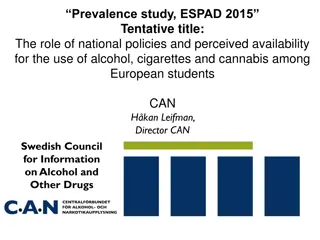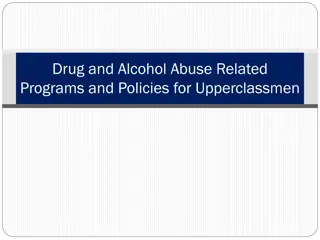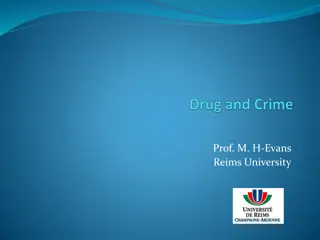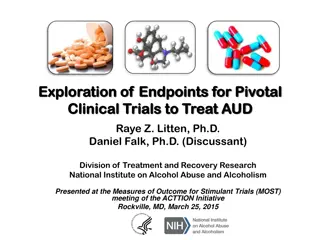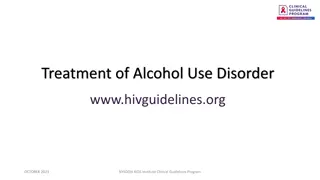Alcohol Use Outcomes in Substance Use Disorder Trials
This presentation provides an in-depth overview of assessing alcohol use outcomes in substance use disorder (SUD) trials. It covers various assessment methods, common outcomes like percent days abstinent and heavy drinking days, preferred outcomes such as percentage of heavy drinking days (PHDD), and the use of biomarkers for validation. The importance of accurate self-reporting and validated outcome measures in clinical trials for alcohol use disorders is emphasized.
Download Presentation

Please find below an Image/Link to download the presentation.
The content on the website is provided AS IS for your information and personal use only. It may not be sold, licensed, or shared on other websites without obtaining consent from the author.If you encounter any issues during the download, it is possible that the publisher has removed the file from their server.
You are allowed to download the files provided on this website for personal or commercial use, subject to the condition that they are used lawfully. All files are the property of their respective owners.
The content on the website is provided AS IS for your information and personal use only. It may not be sold, licensed, or shared on other websites without obtaining consent from the author.
E N D
Presentation Transcript
Overview of Substance Use Overview of Substance Use Outcomes in Other SUD trials Outcomes in Other SUD trials Brian D. Kiluk, Ph.D. Yale School of Medicine ACTTION Meeting March 23, 2018
OUTLINE Published reviews of outcomes in trials for tobacco, alcohol, stimulants Assessments for measurement of outcomes Definitions of treatment success Consideration of grace period Recommended/approved outcomes
ALCOHOL: Assessment Self-report (Timeline FollowBack TLFB, Form 90, etc.) Days of drinking/abstinence Quantity of drinks per day Biochemical / objective measures of drinking Breath Alcohol Concentration (very recent alcohol use <12 hours) EtG urine metabolite (sensitive to heavy drinking in past 24-48 hours) Liver enzymes GGTP, ASAT, ALAT Transdermal alcohol monitor (SCRAM bracelet)
ALCOHOL: Assessment * Self-reports are generally accurate and can be used with confidence when: Alcohol free when interviewed Given written assurances of confidentiality Interviewed in setting that encourages honest reporting Clearly worded objective questions Provided memory aids
ALCOHOL: Common Outcomes Percent days abstinent (PDA) or Percent days drinking (PDD) Days of alcohol abstinence (or use) / Total days Percentage of Heavy Drinking Days (PHDD) Heavy drinking day = any day consuming 4+/5+ drinks for women/men Drinks per Day (DPD) Number of total drinks / number of days during specified period Drinks per Drinking Day (DDD) Number of total drinks / number of drinking days during specified period * Biomarkers commonly used to validate self-report, not as outcome * Transdermal alcohol monitors days of no drinking
ALCOHOL: Preferred Outcomes Allen (2003) Executive summary of conference sponsored by NIAAA Goal of selecting a sentinel outcome measure to include in clinical trials Percentage of Heavy Drinking Days PHDD (continuous) FDA approved endpoints Percent of subjects abstinent (i.e., completely abstinent for specified period) Percent of subjects with no heavy drinking days PSNHDD (dichotomous) No heavy drinking days associated with lower risk of AUD and negative consequences
ALCOHOL: Grace Period Falk et al 2010 PSNHDD Effect sizes based on various grace periods COMBINE and Topiramate
ALCOHOL: Reduction Measures World Health Organization (WHO) risk levels Increased mortality risk at each level of consumption European Medicines Agency Reduction by 2 categories Nalmefene approval Witkiewitz et al 2017 (COMBINE) 1-level reduction Reduced DrInC; better mental health Hasin et al 2017 (NESARC) Table 1 1-level reduction Lowered odds of alcohol dependence
TOBACCO: Assessment Abstinence measures Self-report (TLFB, Nicotine Use Inventory, etc.) Biochemical verification Exhaled carbon monoxide (> 6-8ppm indicative of recent smoking; although 3-5ppm suggested recently) Cotinine (plasma, saliva, urine detection times of several days to a week) Use measures Number of cigarettes per day
TOBACCO: Outcomes Hughes et al., (2003) Workgroup formed by Society of Nicotine and Tobacco Research Gathered information via literature searches to evaluate pros and cons of abstinence measures Included logic, clinical wisdom, and consensus among experts Abstinence measures based on percentage of individuals abstinent Any smoking treated as failure Those lost to follow-up treated as SMOKERS
TOBACCO: Common Outcomes Continuous abstinence Proportion of people not smoking at all since quit date Prolonged abstinence Proportion abstinent for some specified interval of extended duration Point prevalence abstinence Proportion not smoking at a point in time (immediately preceding follow-up) Repeated point prevalence Point prevalence abstinence at 2 or more follow-ups between which smoking is allowed
Hughes, Carpenter, & Naud (2010) 28 RCTs of validated pharmacotherapies Reported both PA & PP PP & PA highly correlated r = .88 Produce similar estimates of effect size PP slightly higher when absolute difference used
TOBACCO: Recommendations from workgroup 2-week grace period recommended Definition of failure requires smoking on several occasions (not just a puff) Smoking on 7 consecutive days, or at least once each week for 2 consecutive weeks Prolonged abstinence is preferred measure 7-day point prevalence should also be reported Many trials have reported only point prevalence 7-day window can be verified by blood or saliva cotinine Definition of failure for 7-day point prevalence is any smoking (even a puff)
STIMULANTS: Assessment Self-report (TLFB) Day-by-day calculation of abstinence / drug use Longest duration of abstinence Biochemical verification Urine toxicology 3-4 days detection Saliva / sweat / hair Percentage of negative/positive results Use Measures No accepted meaningful outcomes based on use (i.e., no heavy use equivalent) No standard quantity
STIMULANTS: Common Outcomes Percentage of days abstinent (PDA) Self-reported days of abstinence / total days in specified period Longest duration of abstinence Maximum number of self-reported days Percentage of positive (or negative) urine toxicology results Urine result only; highly variable based on denominator Percentage of subjects achieving abstinence of x duration Based on dichotomous indicator of achieving abstinence or not Donovan et al, Addiction (2012) No single clinical metric appropriate for all trials Ideally would combine self-report and biological indicators Most appropriate outcome will vary by study methods and goals
STIMULANTS: Comparison of Outcomes Carroll et al (2014) Pooled data across 5 RCTs evaluating treatment for cocaine (N=434) Compared common continuous and dichotomous outcomes Reduction indicators based on days of cocaine use Evaluated correlations with cocaine use during follow-up Determined sensitivity to effects of pharmacologic and behavioral treatments * Rates of discordance b/w self-report and urine results ranged 8-16%
Days of cocaine Use Month 1 Days of cocaine Use Month 3 Days of cocaine Use Month 6 Days of cocaine Use Month 12 Abstinent throughout FU r p r p r p r p Percent cocaine negative urine specimens -.31 .00 -.30 .00 -.39 .00 -.46 .00 -.28 .00 -.24 .00 -.37 .00 -.35 .00 -.30 .00 -.26 .00 -.35 .00 -.30 .00 -.16 .01 -.12 .02 -.24 .00 -.21 .00 .33 .00 .30 .00 .19 .00 .32 .00 Maximum consecutive days of abstinence Percent days of abstinence Days of consecutive abstinence during participants last two weeks of treatment r p Percent completely abstinent last two weeks of treatment -.30 .00 -.25 .00 -.19 .00 -.07 .25 .28 .00 r p r p r p r p r p r p r p Percent attaining 3+ weeks of abstinence -.33 .00 -.26 .00 -.27 .00 -.14 .00 -.32 .00 -.02 .65 -.08 .08 -.30 .00 -.26 .00 -.22 .00 -.08 .12 -.26 .00 -.01 .76 -.07 .14 -.28 .00 -.28 .00 -.24 .00 -.11 .03 -.22 .00 .02 .67 -.04 .42 -.16 .00 -.14 .01 -.10 .05 -.09 .09 -.11 .07 .04 .49 -.01 .92 .25 .00 .24 .00 .11 .02 .23 .00 .18 .00 -.16 .00 -.11 .02 Percent attaining 2+ weeks of abstinence Percent attaining 1+ week of abstinence Percent abstinent during treatment Percent reduction in frequency of cocaine Percent attaining 50% reduction Percent attaining 75% reduction
STIMULANTS: Preferred Outcomes MOST Meeting - Kiluk et al (2016) No single preferred outcome Reduction-based measures defined by quantity should be abandoned Any reduction should be based on days of use Urine drug screens are essential component Used to corroborate self-report rather than primary outcome Pursue low-risk cocaine use by evaluating patterns ( intermittent use ) E.g., 1-4 days per month
SUMMARY OF OUTCOMES Alcohol Only substance with approved low-risk outcome (PSNHDD) WHO risk-levels promising as reduction indicator Tobacco Abstinence-based only (PA or PP) 7-day point prevalence (self-report w/ verification) Missing as failure Stimulants Prolonged abstinence Frequency-based only (not quantity) Urine results commonly used as outcome
